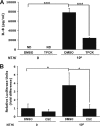Cigarette smoke inhibits airway epithelial cell innate immune responses to bacteria
- PMID: 20194598
- PMCID: PMC2863539
- DOI: 10.1128/IAI.01410-09
Cigarette smoke inhibits airway epithelial cell innate immune responses to bacteria
Abstract
The human upper respiratory tract, including the nasopharynx, is colonized by a diverse array of microorganisms. While the host generally exists in harmony with the commensal microflora, under certain conditions, these organisms may cause local or systemic disease. Respiratory epithelial cells act as local sentinels of the innate immune system, responding to conserved microbial patterns through activation of signal transduction pathways and cytokine production. In addition to colonizing microbes, these cells may also be influenced by environmental agents, including cigarette smoke (CS). Because of the strong relationship among secondhand smoke exposure, bacterial infection, and sinusitis, we hypothesized that components in CS might alter epithelial cell innate immune responses to pathogenic bacteria. We examined the effect of CS condensate (CSC) or extract (CSE) on signal transduction and cytokine production in primary and immortalized epithelial cells of human or murine origin in response to nontypeable Haemophilus influenzae and Staphylococcus aureus. We observed that epithelial production of interleukin-8 (IL-8) and IL-6 in response to bacterial stimulation was significantly inhibited in the presence of CS (P < 0.001 for inhibition by either CSC or CSE). In contrast, epithelial production of beta interferon (IFN-beta) was not inhibited. CSC decreased NF-kappaB activation (P < 0.05) and altered the kinetics of mitogen-activated protein kinase phosphorylation in cells exposed to bacteria. Treatment of CSC with antioxidants abrogated CSC-mediated reduction of epithelial IL-8 responses to bacteria (P > 0.05 compared to cells without CSC treatment). These results identify a novel oxidant-mediated immunosuppressive role for CS in epithelial cells.
Figures





Similar articles
-
Cigarette smoke decreases innate responses of epithelial cells to rhinovirus infection.Am J Respir Cell Mol Biol. 2011 Jan;44(1):118-26. doi: 10.1165/rcmb.2009-0266OC. Epub 2010 Mar 11. Am J Respir Cell Mol Biol. 2011. PMID: 20224072 Free PMC article.
-
Inhibition by cigarette smoke of nuclear factor-κB-dependent response to bacteria in the airway.Am J Respir Cell Mol Biol. 2011 Feb;44(2):155-65. doi: 10.1165/rcmb.2009-0454OC. Epub 2010 Mar 26. Am J Respir Cell Mol Biol. 2011. PMID: 20348206 Free PMC article.
-
Inhibition of IFN-gamma-dependent antiviral airway epithelial defense by cigarette smoke.Respir Res. 2010 May 26;11(1):64. doi: 10.1186/1465-9921-11-64. Respir Res. 2010. PMID: 20504369 Free PMC article.
-
The role of airway epithelial cells and innate immune cells in chronic respiratory disease.Nat Rev Immunol. 2014 Oct;14(10):686-98. doi: 10.1038/nri3739. Epub 2014 Sep 19. Nat Rev Immunol. 2014. PMID: 25234144 Free PMC article. Review.
-
Host defense peptides in the oral cavity and the lung: similarities and differences.J Dent Res. 2008 Oct;87(10):915-27. doi: 10.1177/154405910808701011. J Dent Res. 2008. PMID: 18809744 Free PMC article. Review.
Cited by
-
Increased Risk of Bacterial Infections among the Obese with Chronic Diseases.J Nutr Health Aging. 2015 May;19(5):595-600. doi: 10.1007/s12603-015-0472-5. J Nutr Health Aging. 2015. PMID: 25923492
-
Panel 5: Microbiology and immunology panel.Otolaryngol Head Neck Surg. 2013 Apr;148(4 Suppl):E64-89. doi: 10.1177/0194599812459636. Otolaryngol Head Neck Surg. 2013. PMID: 23536533 Free PMC article. Review.
-
Tobacco and Antiretrovirals Modulate Transporter, Metabolic Enzyme, and Antioxidant Enzyme Expression and Function in Polarized Macrophages.Curr HIV Res. 2018;16(5):354-363. doi: 10.2174/1570162X17666190130114531. Curr HIV Res. 2018. PMID: 30706821 Free PMC article.
-
Cigarette smoke condensate attenuates phorbol ester-mediated neutrophil extracellular trap formation.Afr Health Sci. 2017 Sep;17(3):896-904. doi: 10.4314/ahs.v17i3.33. Afr Health Sci. 2017. PMID: 29085418 Free PMC article.
-
Differences in the Inflammatory Response and Corticoid Responsiveness of Human Lung Macrophages and Parenchymal Explants Exposed to Cigarette Smoke Extracts.Basic Clin Pharmacol Toxicol. 2025 Jun;136(6):e70046. doi: 10.1111/bcpt.70046. Basic Clin Pharmacol Toxicol. 2025. PMID: 40344364 Free PMC article.
References
-
- Anto, R. J., A. Mukhopadhyay, S. Shishodia, C. G. Gairola, and B. B. Aggarwal. 2002. Cigarette smoke condensate activates nuclear transcription factor-kappaB through phosphorylation and degradation of IkappaB(alpha): correlation with induction of cyclooxygenase-2. Carcinogenesis 23:1511-1518. - PubMed
-
- Antunes, M. B., B. A. Woodworth, G. Bhargave, G. Xiong, J. L. Aguilar, A. J. Ratner, J. L. Kreindler, R. C. Rubenstein, and N. A. Cohen. 2007. Murine nasal septa for respiratory epithelial air-liquid interface cultures. Biotechniques 43:195-196. - PubMed
-
- Birrell, M. A., S. Wong, M. C. Catley, and M. G. Belvisi. 2008. Impact of tobacco-smoke on key signaling pathways in the innate immune response in lung macrophages. J. Cell. Physiol. 214:27-37. - PubMed
MeSH terms
Substances
Grants and funding
LinkOut - more resources
Full Text Sources
Other Literature Sources

